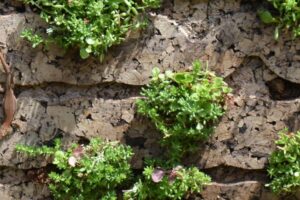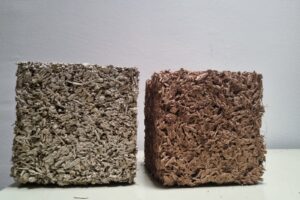
DISCOVER: A comprehensive solution based on AI and robotics to boost circularity in the construction sector
September 9, 2024
BWater: Sustainability and health impact assessment of water for human consumption in Barcelona
September 25, 202412/09/2024
A team of researchers from the materials and structures area of CATMech at UPC is participating in a circular economy project to study the feasibility of using hemp-fiber in five applications in the building sector.
The VALSUCANEM circular economy project, in which the Advanced Centre of Mechanical Technologies (CATMech) at Universitat Politècnica de Catalunya - BarcelonaTech (UPC) has participated, has enabled research into the valorisation of hemp-fiber with the aim of developing an advanced material that can be applied in the construction sector.
A hemp by-product is the short fibre of hemp and is considered a waste material. Within the framework of VALSUCANEM, the feasibility of using this by-product in five different building applications has been studied: thermal and acoustic insulation, chipboard, coffer, and parquet.
The technological challenges of the project have been:
- The creation of a new green material: achieving a green resin or binding material that can form a composite material compatible with hemp-fiber and can be recycled so that the production and life cycle do not generate non-reusable by-products.
- Achieving properties of durability, resistance, stability, and workability that allow the development of solutions for the construction sector such as interior or exterior paving, cladding, urban furniture, etc.
- Developing a proof of concept.
The most promising result has been the thermal and acoustic insulating material made from 70% hemp-fiber and 30% recycled cardboard fibre, achieving insulation performance similar to other existing commercial materials. With the data obtained, the plan is to add a vegetable coating, such as gum arabic or rosin, to protect the material from the environment and citric acid to improve durability and moisture resistance. This new material underwent a 12-month durability process, during which no degradation of its properties was observed. The life cycle analysis of the material indicates that with efficient industrial manufacturing, a material with negative CO₂ emissions could be achieved.
In the energy and resources sector, the project has succeeded in increasing the value of hemp cultivation by reducing waste (by up to 15%) and extending the useful life of hemp-fiber by giving it a high value-added use. It also provides a solution for the extensive use of wood and other synthetic materials currently in use. In the case of wood, although it is a natural product, its growth is very slow (years) compared to the 4 months it takes for hemp to grow, and it also involves significant resource consumption in transportation and logging. Additionally, hemp cultivation requires very few resources and helps to sequester CO₂ from the atmosphere.
The VALSUCANEM project has been carried out in collaboration with the company Lloveras Planteles SL. Achieving the set objectives will help consolidate the company within the agri-food sector and enable it to begin research and development into enabling technologies, as well as expanding its business lines into the commercialisation of hemp waste solutions (not just seedling sales).
Budget and funding
The project has a duration of 3 years (November 2020 - November 2023) and has been allocated a budget of €98,179.24, thanks to a grant from ACCIÓ, the Agency for Business Competitiveness.
Sector
You want to know more?
Related Projects
- A research team from the inLab FIB at the Universitat Politècnica de Catalunya - BarcelonaTech (UPC), together with the Asociación de Personas con Movilidad Reducida (AsoPMR), has taken part in the Spot4Dis project to enhance the mobility and autonomy of people with reduced mobility.
- The La Volta project foresees the construction of a large Catalan vault pergola within the Llars Mundet campus, in the Montbau neighbourhood (Horta-Guinardó district). This structure will become a new architectural landmark for Barcelona, combining traditional construction techniques with contemporary innovation. The project involves the Rehabilitation and Architectural Restoration Research Group (REARQ), at the Universitat Politècnica de Catalunya - BarcelonaTech (UPC), and is led by the Architects’ Association of Catalonia (COAC) and the Barcelona Provincial Council.
SATE-VEG: A system for energy renovation of buildings that helps reduce the urban heat island effect
Researchers from the Architecture, Energy and Environment (AiEM) group at the Universitat Politècnica de Catalunya - BarcelonaTech (UPC) have developed SATE-VEG, an external thermal insulation system with a vegetal coating that offers seasonally adaptive thermal behaviour, enhances urban biodiversity and promotes positive health effects. The system is made from organic materials, requires low maintenance and consumes minimal water.- A research team from the Interdisciplinary Group on Building Science and Technology (GICITED) at the Universitat Politècnica de Catalunya – BarcelonaTech (UPC) is leading the BioSAFE project, which aims to develop sustainable building envelopes —mainly façades— designed according to sustainability, comfort and safety criteria, with particular attention to their acoustic behaviour and fire performance.









